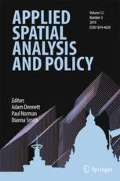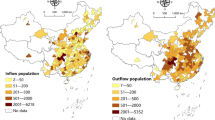Abstract
Understanding the drivers of the floating population’s settlement intentions in Chinese cities is vital to guide evidence-based urban economic development policies. Prior studies have been inclined to use static cross-sectional analysis providing insights into the relative importance of the factors that drive the distribution of urban settlement intentions. Yet, little has adopted longitudinal data approaches to delve into their spatial-temporal patterns and changes in determinants. This study applies China Migrants Dynamic Survey data of 2014–2017 to examine the spatial distribution of urban settlement intentions of floating migrants and their determinants over time. It reveals a persistent and spatially differentiated pattern of urban settlement intentions, where floating migrants relocating to some small and medium-sized cities in several northern parts of China are more willing to settle down. Results from a two-way fixed-effects panel model indicate that both internal motivations and external constraints are closely related to the settlement decision process of floating migrants. The number of family members living together, marriage rate, duration of stay, insurance coverage, the average wage of employees, the proportion of employees in the education industry, and per capita fiscal expenditure positively correlate with settlement intentions, while the proportion of interprovincial floating migrants and urban employment rate have a negative relationship with settlement intentions. Our results further suggest that internal drivers are a prerequisite for external drivers to play a role in driving the urban settlement of migrants.

Similar content being viewed by others
Notes
Since prices level have changed over years, we divide the average annual wage of urban employees by the CPI of the corresponding year.
We apply the Gini index (GI) and Coefficient of variation (CV) to measure the spatial inequality of settlement intentions at the city level. The GI is computed as: \( GI=\frac{1}{2{n}^2\overline{x}}\sum \limits_{i=1}^n\sum \limits_{j=1}^n\left|{x}_i-{x}_j\right| \), where n refers to the number of cities, \( \overline{x} \) is the average of settlement intentions, xi, xj represent the values of settlement intentions in any two cities. The CV is expressed as: \( CV=\frac{1}{\overline{x}}\sqrt{\frac{\sum \limits_{i=1}^n{\left({x}_i-\overline{x}\right)}^2}{n-1}} \), where xi is the value of settlement intention in a city i.
The Moran’s I (MI) is widely used in detecting spatial autocorrelation in the data. It be expressed as: \( MI=\frac{X^{\prime}\boldsymbol{W}X}{X^{\prime }X} \), where X denotes the vector settlement intentions of cities, W represents the distance-based spatial weight matrix.
References
Chan, K. W., Liu, T., & Yang, Y. (1999). Hukou and non-hukou migrations in China: Comparisons and contrasts. International Journal of Population Geography, 5(6), 425–448.
Chan, K. W. (2009). The Chinese hukou system at 50. Eurasian Geography and Economics, 50(2), 197–221.
Chan, K. W. (2019). China’s hukou system at 60: Continuity and reform. Handbook on Urban Development in China, 59–79.
Cao, G., Li, M., Ma, Y., & Tao, R. (2015). Self-employment and intention of permanent urban settlement: Evidence from a survey of migrants in China’s four major urbanising areas. Urban Studies, 52(4), 639–664.
Chen, S., & Liu, Z. (2016). What determines the settlement intention of rural migrants in China? Economic incentives versus sociocultural conditions. Habitat International, 58, 42–50.
Dustmann, C. (2003). Return migration, wage differentials, and the optimal migration duration. European Economic Review, 47(2), 353–369.
Fan, C. C. (2002). The elite, the natives, and the outsiders: Migration and labor market segmentation in urban China. Annals of the Association of American Geographers, 92(1), 103–124.
Fan, C. C. (2005). Modeling interprovincial migration in China, 1985-2000. Eurasian Geography and Economics, 46(3), 165–184.
Fan, C. C. (2011). Settlement intention and split households: Findings from a survey of migrants in Beijing’s urban villages. The China Review, 11–41.
Freeman, L. C. (2000). Visualizing social networks. Journal of Social Structure, 1(1), 4.
Glaeser, E. L., Kolko, J., & Saiz, A. (2001). Consumer city. Journal of Economic Geography, 1(1), 27–50.
Graves, P. E. (1976). A reexamination of migration, economic opportunity, and the quality of life. Journal of Regional Science, 16(1), 107–112.
Gu, H., Xiao, F., Shen, T., & Liu, Z. (2018). Spatial difference and influencing factors of settlement intention of urban floating population in China:Evidence from the 2015 National Migrant Population Dynamic Monitoring Survey. Economic Geography, 38(11), 22–29 (in Chinese).
Gu, H., Liu, Z., Shen, T., & Meng, X. (2019a). Modelling interprovincial migration in China from 1995 to 2015 based on an eigenvector spatial filtering negative binomial model. Population, Space and Place, 25(8), e2253. https://doi.org/10.1002/psp.2253.
Gu, H., Qin, X., & Shen, T. (2019b). Spatial variation of migrant population's return intention and its determinants in China's prefecture and provincial level cities. Geographical Research, 38(8), 1877–1890 (in Chinese).
Gu, H., Meng, X., Shen, T., & Wen, L. (2019c). China’s highly educated talents in 2015: Patterns, determinants and spatial spillover effects. Applied Spatial Analysis and Policy, 1–18.
Gu, H., Liu, Z., & Shen, T. (2020a). Spatial pattern and determinants of migrant workers' interprovincial hukou transfer intention in China: Evidence from a National Migrant Population Dynamic Monitoring Survey in 2016. Population, Space and Place, 26(2), e2250. https://doi.org/10.1002/psp.2250.
Gu, H., Meng, X., Shen, T., & Cui, N. (2020b). Spatial variation of the determinants of China’s urban floating population's settlement intention. Acta Geographica Sinica, 75(2), 240–254 (in Chinese).
Gu, H., Li, Q., & Shen, T. (2020c). Spatial difference and influencing factors of floating Population’s settlement intention in the three provinces of Northeast China. Scientia Geographica Sinica, 40(2), 261–269 (in Chinese).
Haug, S. (2008). Migration networks and migration decision-making. Journal of Ethnic and Migration Studies, 34(4), 585–605.
Huang, X., Liu, Y., Xue, D., Li, Z., & Shi, Z. (2018a). The effects of social ties on rural-urban migrants' intention to settle in cities in China. Cities, 83, 203–212.
Huang, Y., Guo, F., & Cheng, Z. (2018b). Market mechanisms and migrant settlement intentions in urban China. Asian Population Studies, 14(1), 22–42.
Huang, X., He, D., Liu, Y., Xie, S., Wang, R., & Shi, Z. (2020). The effects of health on the settlement intention of rural–urban migrants: Evidence from eight Chinese cities. Applied Spatial Analysis and Policy, 1–19. https://doi.org/10.1007/s12061-020-09342-7.
Lin, L., & Zhu, Y. (2016). Spatial variation and its determinants of migrants' hukou transfer intention of China's prefecture-and provincial-level cities: Evidence from the 2012 national migrant population dynamic monitoring survey. Acta Geographica Sinica, 71(10), 1696–1709 (in Chinese).
Liu, Y., Deng, W., & Song, X. (2018). Influence factor analysis of migrants' settlement intention: Considering the characteristic of city. Applied Geography, 96, 130–140.
Liu, Y., & Shen, J. (2017). Modelling skilled and less-skilled interregional migrations in China, 2000–2005. Population, Space and Place, 23(4), e2027.
Liu, Y., & Shen, J. (2014). Jobs or amenities? Location choices of interprovincial skilled migrants in China, 2000–2005. Population, Space and Place, 20(7), 592–605.
Liu, Y., & Xu, W. (2017). Destination choices of permanent and temporary migrants in China, 1985–2005. Population, Space and Place, 23(1), e1963.
Liu, Z., Wang, Y., & Chen, S. (2017). Does formal housing encourage settlement intention of rural migrants in Chinese cities? A structural equation model analysis. Urban Studies, 54(8), 1834–1850.
Liu, Z., & Gu, H. (2019). Evolution characteristics of spatial concentration patterns of interprovincial population migration in China from 1985 to 2015. Applied Spatial Analysis and Policy, 1-17.
McGranahan, D. A. (1999). Natural amenities drive rural population change (no. 1473-2016-120765).
National Bureau of Statistics of China. (2018). 2017 Migrant Workers Monitoring Survey Report. http://www.stats.gov.cn/tjsj/zxfb/ 201704/t20170428_1489334.html.
Rappaport, J. (2009). Moving to nice weather. In Environmental Amenities and Regional Economic Development (pp. 25–53). Routledge.
Stark, O., & Bloom, D. E. (1985). The new economics of labor migration. The American Economic Review, 75(2), 173–178.
Stillwell, J., Daras, K., & Bell, M. (2018). Spatial aggregation methods for investigating the MAUP effects in migration analysis. Applied Spatial Analysis and Policy, 11, 693–711.
Tan, S., Li, Y., Song, Y., Luo, X., Zhou, M., Zhang, L., & Kuang, B. (2017). Influence factors on settlement intention for floating population in urban area: A China study. Quality & Quantity, 51(1), 147–176.
Tiebout, C. M. (1956). A pure theory of local expenditures. Journal of Political Economy, 64(5), 416–424.
Todaro, M. P. (1969). A model of labor migration and urban unemployment in less developed countries. The American Economic Review, 59(1), 138–148.
Wei, H., & Su, H. (2013). Research on Degree of Citizenization of Rural-Urban Migrants in China. Chinese Journal of Population Science, 2013(5), 21–29 (in Chinese).
Wei, Z. (2013). A region-specific comparative study of factors influencing the residing preference among migrant population in different areas: Based on the dynamic monitoring & survey data on the migrant population in five cities of China. Population & Economics, 4, 12–20 (in Chinese).
Xiang, H., Yang, J., Zhang, T., & Ye, X. (2018). Analyzing in-migrants and out-migrants in urban China. Applied Spatial Analysis and Policy, 11, 81–102.
Xu, Z., & Ouyang, A. (2018). The factors influencing China’s population distribution and spatial heterogeneity: A prefectural-level analysis using geographically weighted regression. Applied Spatial Analysis and Policy, 11, 465–480.
Yang, G., Zhou, C., & Jin, W. (2020). Integration of migrant workers: Differentiation among three rural migrant enclaves in Shenzhen. Cities, 96, 102453.
Yue, Z., Li, S., Feldman, M. W., & Du, H. (2010). Floating choices: A generational perspective on intentions of rural–urban migrants in China. Environment and Planning A, 42(3), 545–562.
Zhu, Y. (2007). China's floating population and their settlement intention in the cities: Beyond the Hukou reform. Habitat International, 31(1), 65–76.
Zhu, Y., & Chen, W. (2010). The settlement intention of China's floating population in the cities: Recent changes and multifaceted individual-level determinants. Population, Space and Place, 16(4), 253–267.
Zhou, L., Tian, L., Gao, Y., Ling, Y., Fan, C., Hou, D., Shen, T., & Zhou, W. (2019). How did industrial land supply respond to transitions in state strategy? An analysis of prefecture-level cities in China from 2007 to 2016. Land Use Policy, 87, 104009.
Acknowledgments
The work described in this study was funded by the National Natural Science Foundation of China (No.71733001), the National Social Science Foundation of China (No. 17ZDA055), and China Scholarship Council (201906010255).
Author information
Authors and Affiliations
Corresponding author
Ethics declarations
Conflict of Interest
The authors claim that they have no conflict of interest.
Additional information
Publisher’s Note
Springer Nature remains neutral with regard to jurisdictional claims in published maps and institutional affiliations.
Rights and permissions
About this article
Cite this article
Gu, H., Jie, Y., Li, Z. et al. What Drives Migrants to Settle in Chinese Cities: a Panel Data Analysis. Appl. Spatial Analysis 14, 297–314 (2021). https://doi.org/10.1007/s12061-020-09358-z
Received:
Accepted:
Published:
Issue Date:
DOI: https://doi.org/10.1007/s12061-020-09358-z




